Lacrosse Strength and Conditioning
One of the most underdeveloped areas behind Lacrosse based training is actually focusing on the strength element. Resistance-based training, the training that can be done inside a weight room. The training that can be done to drastically improve speed, the ability to cut, and hip mobility.

A thing we have seen with LAX bros is squatting to 90* with 225#, trying to get a big pump to achieve a swole upper body through the bize and trize. Throw in some shredded abs to go with the beach look decor. The problem is they are basically doing a bastardized sports performance program that is primarily focused on bodybuilding.
Then there is the other camp that doesn’t want to get slow, become big bulky, and shy away from lifting too much. They don’t want to struggle to have solid speed. That’s kind of bogus.
We need to break down what exactly lacrosse players need. See, when we at Garage Strength look out on the field, we see a sport that resembles sports like field hockey, pole vaulting, and throwing shots--sports with movements that have a lot of rotation. We also see in lacrosse a sport that requires running with pads (similar to football), handling an odd object, and the need to be fast.
From this point, we need to break lacrosse down and start to see what lacrosse athletes need to improve their play on the field.
4. Strength Endurance
Strength endurance is a big factor in the sport of lacrosse.
In the early days of Garage Strength, we wanted to train lacrosse players similar to how we trained linebackers. Now maybe there are specific positions on the lacrosse field that this style of training may apply to and have great carryover, however for most positions on the lacrosse field we believe that it is more comparable to a free or strong safety in football. Someone who has really good speed but still has tremendous endurance later in the game. We can even think about 200 or 400-meter runners. We want athletes with good speed and solid endurance in the latter half of the game.
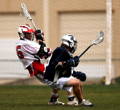
With this key element of strength endurance, we have to have long, big sets. Sets that go over for a long period of time. We can have sets that have athletes under tension for one to two minutes. Maybe we take some finishers, like long-duration lunges or isolation work. We can even start using the sauna for top-level athletes to improve their endurance without banging them up physically.
3. Mobility
A focus on mobility in the sport of lacrosse is a must. Anyone who watches a lacrosse game sees a lot of crazy movements. Bodies twist, turn, and end up in precarious positions while still being asked to be stable, strong, and athletic. This means lacrosse athletes need mobility throughout the entire body: hips, ankles, knees, thoracic extension, and thoracic rotation to name a few. Lacrosse players need to be able to move freely through a lot of various planes.
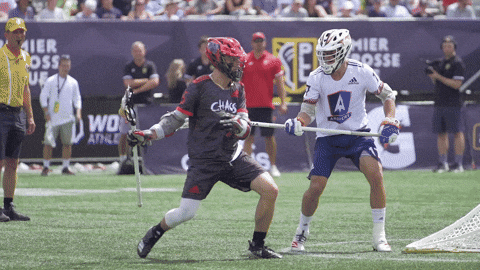
It isn’t just sitting there and having athletes be passively flexible. We actually have to train high-speed mobility. For instance, training high-speed mobility with thoracic rotation, that will help athletes’ shot speed increase dramatically. If we train rotational speed it will create more mobility in the lower back to have faster shots as well. More mobile hips will allow for better cuts to set up a shot or make a really effective pass.
Another key factor with this rotation and changing hands with the stick, upper body mobility is a must. Movements and exercises like power cleans, power snatches, overhead lunges, or side medicine ball work will improve the upper body’s mobility for thoracic extension. This helps a lot on the field and leads right into the next key factor in training strength for lacrosse.
2. Dynamic Trunk Control
Any athlete who is in a sport where an object is held while running full speed, like a stick, demands cutting in various angles, and athletic skills are needed to excel, dynamic trunk control has to be a focus. DTC needs to be broken down and placed within the periodization as a target.
Specifically, with lacrosse, we have to think about running full speed down the field with a stick. Think about pole vaulters, ice hockey, or field hockey athletes. These sports give us ideas of how to make the trunk stable. On top of that, lacrosse is an extremely high contact sport. Let’s face it, people with really strong trunks feel like a house of bricks when contact is made. This comes from having a very stable trunk. Athletes with supreme dynamic trunk control are able to flex their entire trunk, absorb the contact, and deliver it back into the opponent.

We can factor movements like a power snatch or other aggressive movements that improve dynamic trunk control, like a rotating dumbbell snatch into a hip lock. These movements will not only improve the DTC but will train explosiveness to help athletes run faster.
1. Speed
Speed is a no-brainer.
We can improve the speed of athletes with unilateral work like single-leg squats, step-ups, explosive lunges, or unilateral plyometrics.
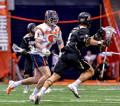
However, speed means nothing if we don’t develop athletes with dynamic trunk control, mobility, especially hip and thoracic rotation based mobility, and it definitely means jack if late in the game we have no strength endurance to have a foundation for that top-end speed.
We do know that faster athletes tend to see the field better than their slower opponents to allow faster athletes to make better decisions cognitively.

We need to train all four aspects: strength endurance, mobility, dynamic trunk control, and speed to develop a fully rounded lacrosse athlete. Each aspect and component factor into one another. The individual aspects are interconnected and demand the proper periodization to reap the greatest rewards. Utilize each aspect in a thoughtful manner and reap the rewards with more speed on shots, greater speed later in the game, better positions for advantages on the field, and the jets to leave opponents in the dust. Just make sure to practice the technical work of handling the ball and stick on the field as well.

Upper Body Exercises
When we are talking about lacrosse and playing lacrosse on the field and thinking about the upper body, we need to think about what type of actions go into an actual lacrosse game. We need to think about what type of movements we will be training. We need to consider what we are trying to improve from a strength perspective that transfers to the field.
Immediately, we need to understand that in lacrosse we need to use our lats. Passing or taking a high velocity shot, we use our lats. We have to train the lats. Our lats play a key role in guiding the ball and pulling the stick.
We also need to think about dynamic trunk control. We are doing a lot of running, sprinting, and holding a stick. All of this factors in to how we train our upper body.
Finally, there is a ton of rotation in lacrosse. So not only are we training lats and dynamic trunk control, we need to be able to rotate rapidly in a manner that we use the rotation effectively to increase speed and power.
It is key that we use this lens with these three key elements to trigger and develop this upper body workout for lacrosse. You can find all these physical aspects within the lacrosse strength programs from Peak Strength that will guide you build these sport-specific adaptations.
1. Single Arm Dumbbell Incline Press
In lacrosse we need to train side to side, unilateral work, a lot of rotation, core stability, and because there is a lot of pummeling involved with aggressive behaviors, we want to focus on the big pop from the press. The single arm dumbbell incline press checks all the boxes. Side to side? Check. Unilateral work? Check. Rotation? Eh, the ability to decelerate a rotation, so check. Aggressive pummeling? Check.

Do two to three sets of four to six reps on each arm. Pair this movement with together with the next movement. Give a thirty to forty second rest before starting the next movement.
2. Pull Ups & Quarter Reps
Because there is a lot of lat involvement on the field when playing lacrosse, we like to utilize more time under tension with a pull up. The pull up can be performed as a pull up, a chin up, a neutral grip pull up, or any variation of the pull up that is preferred. Use them all.
However, to increase that time under tension, we are all about the pull up then quarter rep, rinse and repeat. So full pull up, quarter pull up, full pull up, quarter pull up, and so on and so on. This method adds more time to the targeted muscle grouping being under tension.
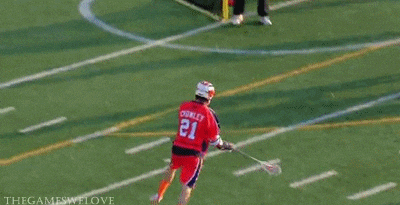
We like to see two to three sets of this movement performed. The thing about the pull up & quarter reps is it lengthens the lats multiple times in one set. So six full reps paired with quarter reps in between gets us to double digit reps.
Just remember, we are trying to improve the lats and shoulder stability. These two movements paired together do just that.
3. Gorilla Push Ups
We want to train lacrosse players similar to football strong safeties and free safeties. Lacrosse athletes need to be really, really fast while being extremely explosive. This goes into upper body work as well. That brings us to gorilla push ups.
Gorilla push ups are brutal. The good thing is gorilla push ups teach athletes how to be coordinated and explosive from the upper body perspective. To perform the movement, an object, like a med ball is needed. One hand is on the med ball and the other hand is on the ground. From there, we perform a push up. The push up need tos be explosive, similar to a clapping push up, propelling the hands off the ground an object. The big difference with this variation of the push up is that the hand on the ground needs to move horizontal to land on the object, ideally a med ball, while the the hand that was on the med ball moves to the ground. The movement is rapidly performed then back and forth, the hands moving side to side, on and off the med ball or object.

We want to aim to perform two to three sets of six to ten reps. We want to react quickly. Once we hit, we try to change directions as quickly as possible. This will go far in helping lacrosse players bump opponents off of them on the field.
Now rest thirty to forty seconds before heading into the next movement in this pairing.
4. Reclining Bat Wings
Ideally to perform this movement we have rings. When using the rings, we want to focus on a little bit of shoulder external rotation. Similar to a ring row, we hang from the rings. Except we want to focus on shoulder external rotation. Elbows stay almost exactly in line with the shoulders. A slower eccentric helps a lot. Make sure to externally rotate with the hands and the shoulders. This will be felt in the rhomboids, rear delts, and a little in the traps. It will help stabilize the shoulder to apply a ton more force when trying to throw a nice aggressive pass. Do this for two to three sets of ten to fifteen reps.

Now if rings are not available, a PowerLastic band is the next best thing. Wraps the band around an immovable object and hit some banded external rotations. Once again, this can be done for two to three sets of ten to fifteen reps. And if no bands are available, dumbbells can work as well.
5. Banded Rotations Slow Eccentric
With these next two movements we are focusing on being super explosive. We want to see the hip almost turned facing a pole with a PowerLastic band attached to the pole. We want longer arms. Now if the right hand is holding the handle, we want to be rotating to the left. Make sure to perform a nice slow eccentric on the return to the start position. Do two to three sets of five to six reps on each side. Focus on training both aspects while feeling the feet grounded. This movement will help lacrosse players rotate faster and have superior dynamic trunk control.
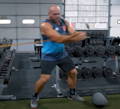
We then want to super set this movement with our next exercise.
6. Med Ball Slams
We want to see more rotation performing the med ball slam. We want to do two to three sets of five to ten reps. The reason for this exercise is because it improves the overhead strength and explosiveness.
Pairing the med ball slam with the banded rotation, lacrosse athletes will feel the trunk work even greater. The pairing helps acceleration, dynamic trunk control, and the rotational, explosive power.

These six exercises are specific to benefitting lacrosse athletes. The upper body exercises focus on dynamic trunk control, rotational explosiveness, and targeting the lats. A big key when performing this upper body workout is to remember that each exercise is paired with a corresponding movement to greater target the desired strength and power development necessary to have more success out on the lacrosse field. Give Peak Strength a try and let us know how it goes!
Lower Body Exercises
When we are talking about traditional strength training, we have got to think about different movements and different actions that can lead to developing a better lacrosse player. To do that, we have to take a step back and think about what goes into lacrosse from a big top-down perspective. Athletes have to have really good strength endurance because there is a lot of running, a lot of power involved, and it is a long game on the field. Athletes also have to have good mobility; they need thoracic rotation, mobile lower back, and mobile ankles and hips to make better cuts, run faster, and accelerate a little bit more rapidly. Athletes also need to have very good dynamic trunk control to make sharper cuts and to be able to see the field a little clearer. Finally, athletes need to be fast. Equally skilled players, the faster person will always win.

So we have to train speed, dynamic trunk control, strength endurance, and mobility. We have to think about these four elements when developing that strength training regiment.
4. Barbell Step Up
The barbell step up is a unilateral exercise. We want to be using 18-22” inch boxes so we can get decent hip flexion. While performing the movement, we want to really think about driving with the quad and driving with the glute. The movement is loaded. Performing the movement we want to have a minimal drive from the back leg, the leg on the ground. The front leg is fully on the box and drives hard until the knee locks out. Once the knee is locked out the foot can get onto the box.
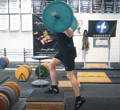
We recommend doing four to five sets of five to seven reps on each leg. We want to think about driving rapidly during the step up but then controlling the movement through the eccentric. We don’t want to just plop back down.
By developing the quads and glutes, this exercise will help us run faster. On top of that, because we are doing both legs with the barbell on the back, that will improve dynamic trunk control. Bracing in the trunk is a must.
3. Pause Back Squat
This is a bilateral movement. We prefer a high bar back squat because when we are playing lacrosse, players are seen typically in an upright trunk position. On top of that, we want to train a bit more of dynamic trunk control as if running at full speed or through acceleration. Training with a low bar asks for more hip flexion that might not carry over as well to the lacrosse field, thus we recommend using the high bar.

We’d also prefer to see a slower eccentric with a three to five-second count into the bottom. Along with slow eccentric, the pause in the bottom helps with hip and ankle mobility. We can do three to six sets for four to five reps. We can even throw in a drop set. This will help increase posterior chain strength, overall mobility, absolute strength, and muscular coordination through the anterior sequence. In addition, if we do a drop set of ten reps, our strength endurance will increase greatly. The added strength will also help us cut more rapidly.
Don’t go crazy with the load, just progress properly. We believe that collegiate men should be able to back squat 315# ass to grass for a set of five. Collegiate women should be able to hit 80 to 100 kilos. These numbers aren’t out of this world.
2. Single Leg Glute Ham Row
This is a truly unique movement.
We want to see a unilateral position in the GHD. We want one leg in and one leg out. The kicker is, if the right leg is in, we want the dumbbell to be held in the left hand. The opposite goes as well, if the left leg is in, we want the dumbbell to be held in the right hand. We will go down, come back up, and row. This is contralateral training with a unilateral perspective.

Why are we doing this? The reason why we want to do this is that we are training the posterior chain: butt, hamstring, and lower back. Now with the dumbbell in the opposite arm, when we get to the top and row we are training dynamic trunk control. Performing nine reps on each side for four to five sets trains strength endurance.
This is a really hard movement. Thankfully it helps with speed tremendously. The exercise lights up the hamstrings. It puts us in an isometric muscular action when performing the row, so now the trunk has to coordinate with the hamstring. In addition, with lacrosse, there is a lot of rotation, in which this exercise helps train rotation as well as anti-rotation movement.
1. Two-Box Power/Full Clean
It has been our experience at Garage Strength that a lot of lacrosse players do not like to get into the gym and perform the snatch and clean and jerk or variations of the snatch and clean and jerk. Or they’ll boast of cleaning 225# as a male lacrosse player in college or 130# as a collegiate female lacrosse player. These are numbers that young high school athletes can hit.
The point is, we want to see lacrosse players increase the speed of their shots. And the thing is if we can create more rapid coordination, more trunk coordination, and a little bit more rotation, we can generate a lot more force. This is a key, pivotal point to developing faster passes and shots.

That’s where the two-box power clean followed by a full clean comes into play. It is a complex. The thing is we want to see a rapid catch and then a rapid catch into the hole to help improve mobility.
Typically, we want each box to be seven to eight inches in height, placing the bar just above the knee. If boxes are in the playing cards, we can perform the movement by doing a high hang power clean into a high hang full clean. The key is good strong hip extension, good strong upper body shrug, and then rapidly absorb the energy through the trunk, back, and legs. This can be taken out onto the field to be used to an advantage on the field.
Do this complex twice a week. Make sure to push the weight a bit as well. Using this complex of exercises will help athletes coordinate faster and develop power a little bit quicker.

Recap
Utilize all four of these exercises. In addition, recognize that there are some bilateral movements, unilateral movements, contralateral movement, and a big explosive movement being performed. The great thing about the use of these movements is that they will help athletes dominate out on the field. The exercises will lead to faster running, improve mobility, better dynamic trunk control, and superior strength endurance. If you want more strength training exercises for lacrosse, checkout the Peak Strength app that houses over 700 different exercises and creates strength programs specific to making you a freak on the lacrosse field.
DANE MILLER
Dane Miller is the owner and founder of Garage Strength Sports Performance. He works with a select handful of clients on building comprehensive programs for fitness and nutrition. Several times a year he leads a workshop for coaches, trainers, and fitness enthusiasts.

